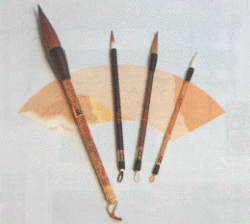The production of the Kumano brushes started at the end of the Edo period.
The background for the somewhat strange fact, that brush making started in an are lacking
the crude materials bamboo and hairs is as follows.
During the Edo period Kumano was a town with little farm land and during seasons of little
agricultural work many men went to Yoshino in Yamato (present day Nara Prefecture) to work
temporarily in forestry.
During seasons of high agricultural activities these men returned from Nara where they
had purchased brushes and ink which they intended to sell back home. This was the incentive
that led the people to brush making.
In 1846 a citizen of Kumano, Jihei Inoue, learned the art of brush making from Seizou Yoshida,
a craftsman who order made brushes for the feudal lords of Aki, the Asano family.
During the same period Tsuneta Otomaru mastered brush making in Arima in the Settu
(present day Hyogo Prefecture) district and handed the craft locally down.
In 1872, when education became obligatory, the demand for brushed increased. A little later,
in 1877, the reputation of the Kumano brushes spread when they were recommended because of
their high quality by the local industrial promotion and exhibition association'.
Presently, there are 140 brush manufacturers with a total of 4,000 employees within the city.
The production volume is as much as 140 hundred million brushes and shipment value reaches 8
billion Yen, which is about 80% of the national share.
Although the demand for brushes has decreased in these days, development of new articles,
including brushes for painting or cosmetic application, still allowed to increase the
production.
Every year in September since 1935 the magnificent "brush festival" is held within the
precincts of the Sakaki Shrine.
Here memorial services are held for old brushes collected from all over Japan, writing
contests conducted and manufacture presentations made.
Also, in 1994 the "Brush Rikobo" was built as a part of the city activation project' to
improve the image "brush city Kumano" and attracted tourists from all over Japan.
This was the first time that a craft of this prefecture had been designated a traditional
craft (1975).
|
 |

